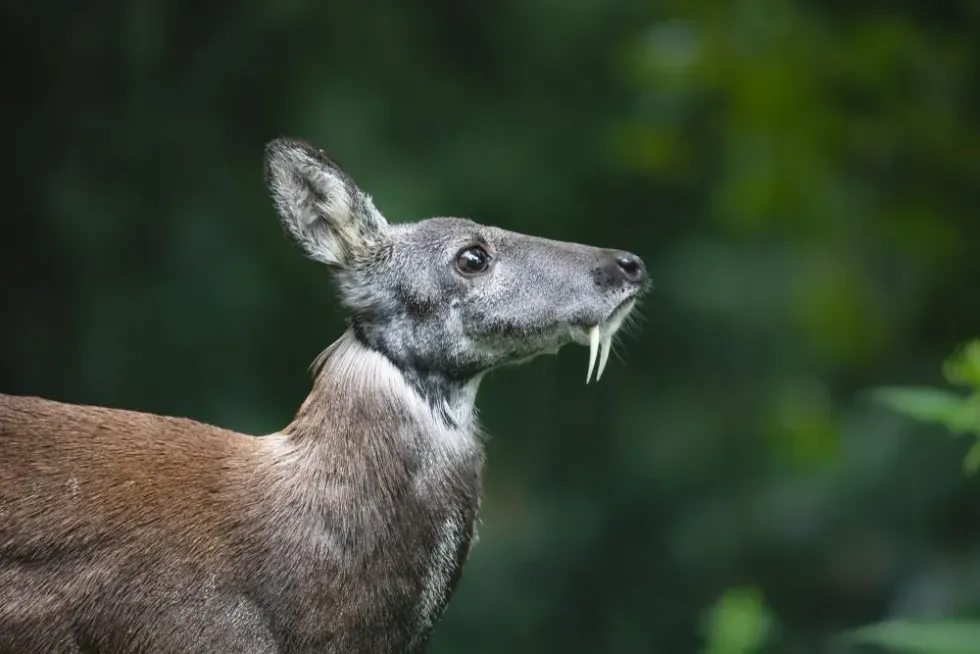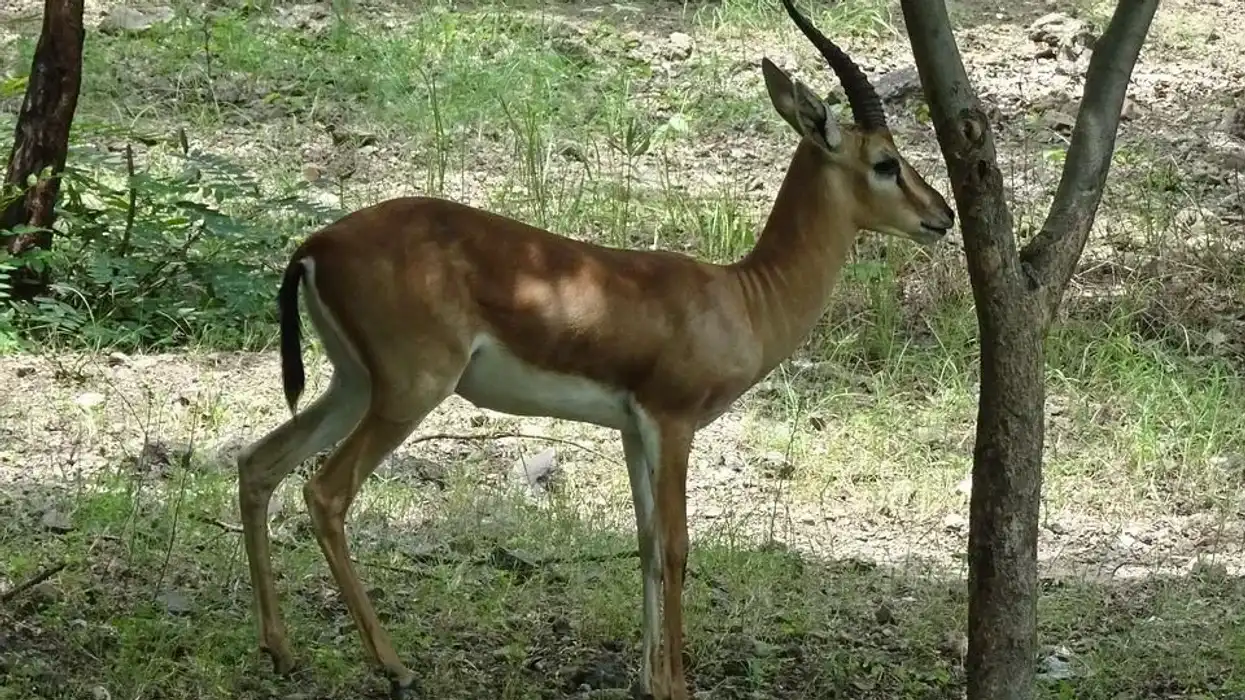The Kashmir musk deer (Moschus cupreus) is an endangered mammal species found in several parts of Asia: Afghanistan, Pakistan and the northeastern parts of India (Himalayas), also in a few western parts of Nepal. Due to gradually increasing deforestation, changing habitats, and lack of laws for hunting, these deer are rarely found.
This Endangered species is listed in the IUCN red list.
These deer are said to be subspecies of alpine musk deer, but now they are referred to as different species of their own. The other musk deer are Himalayan musk deer (Moschus leucogaster), Siberian musk deer (Moschus moschiferus), and black musk deer (Moschus fuscus).
The male musk deer only have tusks they use while mating. These deer are sexually matured at the age of one and half years. The Himalayan musk deer generally do their mating from the months of November to January.
To know more about deer, you can read more interesting facts about the black-tailed deer and key deer.
Kashmir Musk Deer Interesting Facts
What type of animal is a Kashmir musk deer?
This is a threatened international mammal, found in many areas of Asia, covering northern parts of India, the south region of China, a major region of Pakistan and Afghanistan, and also has a presence in Nepal.
It is from the Moschus family, where there are seven other species of this Moschus family such as Moschus fuscus (black or dusky musk), Moschus moschiferus (Siberian musk deer).
What class of animal does a Kashmir musk deer belong to?
The Kashmir musk deer (Moschus cupreus) is of the Mammalia class and of Moschidae family. These deer are referred to as alpine deer (M. chrysogaster).
How many Kashmir musk deer are there in the world?
There are less than 5000 musk deer present throughout the world due to illegal hunting for their scent glands.
In Nepal (south of Annapurna Himalayas), musk deer are endangered with an extending range from India, Pakistan to east Afghanistan and in few areas of China (mountains of Mustang in the west, Manang and Kaski). The population of these deer is threatened in many areas of Asia.
Many other species of this Moschus family are endangered in many areas of Asia, such as Anhui musk deer and Siberian musk deer (Moschus moschiferus).
Where does a Kashmir musk deer live?
The Kashmir musk deer don't live below 3,280.8 ft (1 km). The other deer of this species, such as forest musk deer, generally occur in Tibet, various national provinces of China like Guizhou, Anhui, Hubei, Hunan, and Guangxi, Laos.
These vampire deer or musk deer are totally forest-loving species and are found in the various Himalayas, central and north Asia, and Siberia.
What is a Kashmir musk deer's habitat?
These deer's habitats are generally found in the dense forests, scrub, high mountains of different regions of Asia. Their habitat range lies between 7,217.9-14,107.6 ft (2.2-4.3 km). During the day, they spend time within the dense bushes, and they are more active during night time in the forest.
Who do Kashmir musk deer live with?
The musk deer is one of the threatened species, which are specialist solitary animals found in various regions of Asia. These endangered species of deer like to live alone in the woods, unlike reindeer.
How long does a Kashmir musk deer live?
The average lifespan of M. chrysogaster (Alpine musk deer) is about seven years. The oldest deer of all the seven species are dwarf musk deer from China, which is about 20 years. It is assumed the Kashmir musk deer lifespan is within that range.
How do they reproduce?
The mating season is from November to January. But a few female musk deer don't mate until March.
The male deer have musk sacs, special glands used to lure the female ones from hiding during the mating season, as the male becomes aggressive and guards their territory against others. They fight with other male deer to win over the female deer. The average development period of them is around 180-200 days.
In May and June, one or twins are born. The newborns have then kept hiding, and their mother feeds them for two months.
What is their conservation status?
The Kashmir musk deer (Moschus cupreus), earlier known as alpine musk deer, was recently listed as an Endangered species in Asia due to habitat loss and poaching for the priced scent glands.
Kashmir Musk Deer Fun Facts
What do Kashmir musk deer look like?
Kashmir musk deer are small deer with large ears, having hind legs longer than their front legs with a very short tail. They are about 31.4-39.3 in (80-100 cm) long.
They are up to 20-28 in (50-70 cm) high while standing. They weigh 15.4-37.4 lb (7-17 kg). These Kashmir musk deer have wavy, long, and thick fur.
The body color of these deer varies from species to species, like golden to grayish brown. The feet of these deer are adapted to climb the mountain like other deer such as black musk deer, Himalayan musk deer (Moschus leucogaster ), Siberian musk deer (Moschus moschiferus), and alpine musk deer.
These deer don't have antlers like fallow deer, but the male musk deer have sharp tusks, which they use during mating season. Also, the musk gland is found in the male deer which lies in a sac. They prefer wildlife nature rather than human habitat.

How cute are they?
The Kashmir musk deer are small creatures with large ears, endangered because of their scent glands. These cute herbivores are found in wildlife regions of many areas in Asia.
How do they communicate?
Although the musk deer are famous for their scent glands and are found to be endangered in India, Afghanistan, and many distributions throughout Asia, their communication is predominantly by olfaction, as they have a shallow sense of smell.
They communicate with the help of their excellent power of vision and hearing, which help them to survive in the wildlife nature of dense forests.
How big is a Kashmir musk deer?
Kashmir musk deer are 19.6–23.6 in (50–60 cm) high at the shoulder. These stand about 31.4-39.3 in (80-100 cm ) long, almost equal to spiral-horned antelopes. They weigh up to 15.4-37.4 lb (7-17 kg).
How fast can a Kashmir musk deer run?
Kashmir musk deer can be extremely fast in the running but can tire after 656.1-984.2 ft (200-300 m). While running, they can leap as long as a snowshoe hare with hind legs longer than the front legs. They can jump up to 16.4-19.6 ft (5-6 m) straight from the ground.
How much does a Kashmir musk deer weigh?
The musk deer are small mammals, weighing 15.4-37.4 lb (7-17 kg).
What are the male and female names of the species?
The Kashmir musk deer of the Moschus family (Moschus cupreus as is its binomial name) is commonly found in Afghanistan, India, and Pakistan and is an endangered animal that doesn't have different names for males and females. But the male deer have scent glands in sacs and tusks.
What would you call a baby Kashmir musk deer?
These animals are from the Moschus family, where they are called Moschus cupreus. There are no special names for the babies in these species.
What do they eat?
They are herbivorous and they eat leaves, flowers, grasses, and also some mosses, lichens.
Are they dangerous?
The fanged deer are generally timid animals but the male deer are somewhat aggressive during the mating seasons as they have to fight and win over the female deer. They have a dominant, aggressive nature to protect their territory and female deer.
Would they make a good pet?
These are endangered species of Asia. Although these deer are solitary shy animals, they are extremely forest-loving species. They can't be kept as pets, and they have fine hind legs that help run over the forests. They are cute to see within nature.
Did you know...
The Kashmir musk deer are called musk deer because the male deers have a gland called pod present in their abdomen used for attracting the female deer, called musk.
Their fangs can easily identify musk deer. Only the male deer have fangs. Thus they are also called 'fanged' or 'vampire' deer. They have fangs because of evolution that happened centuries ago. They grew fangs rather than antlers.
What eats a musk deer?
The musk deer are an endangered species found in central Asia, generally eaten by lynx, yellow-throated marten, and wolverines. They are also poached by humans very commonly because of their prized scent glands.
Here at Kidadl, we have carefully created lots of interesting family-friendly animal facts for everyone to discover! For more relatable content, check out these rabbit fun facts and bison facts for kids.
You can even occupy yourself at home by coloring in one of our free printable Kashmir musk deer Coloring Pages.
*Please note that the main image is of a Siberian Musk Deer that is similar to the Alpine Musk Deer. If you have an image of an Alpine Musk Deer, please let us know at hello@kidadl.com.









